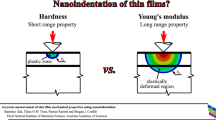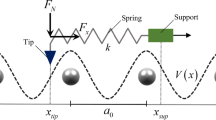Abstract
Molecularly thin lubricants are important in protecting the recording head and the rotating disk in a magnetic storage hard disk drive from mechanical damage induced by contact. Direct contact is more likely to occur at lower head-media spacing, which is the distance between the rotating magnetic disk and the head that reads/writes the data, and is highly desirable to be extremely low (in the nanometer range) for Terabit/in2 areal densities. Solid contact mechanics of the head-disk interface has been well addressed through extensive experiments and modeling, by neglecting the effect of the molecularly thin lubricant. Considering the important role of the lubricant, it is necessary to investigate the contact mechanics that include the lubricant. The present study develops a mechanics-based model to account for the nanoscale phenomena including slippage, nonlinear viscosity and bonded lubricant fraction, thus providing a measure to bridge the hydrodynamic lubrication and solid contact regimes at the nanoscale. Results show that the friction coefficient increases with the bonded ratio, which correlates with experimental observations.









Similar content being viewed by others
References
Barnes HA (2000) Handbook of elementary rheology. University of Wales Institute of Non-Newtonian Fluid Mechanics, Aberystwyth, Dyfed, Wales
Cantow MJR, Ting TY, Barrall EM, Porter RS, George ER (1986) Shear dependence of viscosity for perfluoropolyether fluids. Rheol Acta 25:69–71
Chen C, Bogy DB, Bhatia CS (2001) Effect of lubricant bonding fraction at the head-disk interface. Tribol Lett 10:195–201
Cho JH, Law BM, Rieutord F (2004) Dipole-dependent slip on Newtonian liquids at smooth solid hydrophobic surfaces. Phys Rev Lett 92:166102
Chowdhury S, Vakis AI, Polycarpou AA (2015) Optimization of molecularly thin lubricant to improve bearing capacity at the head-disk interface. Microsyst Technol 21(7):1501–1511
Craig VSJ, Neto C, Williams DRM (2001) Shear dependent boundary slip in an aqueous Newtonian liquid. Phys Rev Lett 87:054504
Gee ML, McGuiggan PM, Israelachvili JN, Homola AM (1990) Liquid to solidlike transitions of molecularly thin films under shear. J Chem Phys 93:1895–1906
Greenwood J, Williamson J (1966) Contact of nominally flat surfaces. P Roy Soc Lond A Mat 295(1442):300–319
Hahm CD, Bhushan B (1997) High shear rate viscosity measurements of perfluoropolyether lubricants for magnetic thin-film rigid disks. J App Phys 81(8):5384
Hirz SJ, Homola AM, Hadziioannou G, Frank CW (1992) Effect of substrate on shearing properties of ultrathin polymer films. Langmuir 8(1):328–333
Itoh S, Fukuzawa K, Hamamoto Y, Zhang H, Mitsuya Y (2008) Fiber wobbling method for dynamic viscoelastic measurement of liquid lubricant confined in molecularly narrow gaps. Tribol Lett 30(3):177–189
Itoh S, Ishii K, Fukuzawa K, Zhang H (2014) Shear thinning of nanometer-thick liquid lubricant films measured at high shear rates. Tribol Lett 53(3):555–567
Karis TE, Tyndall GW, Waltman RJ (2001) Lubricant bonding effects on thin film disk tribology. Tribol Trans 44:249–255
Kato T, Kawaguchi M, Sajjad MM, Choi J (2004) Friction and durability characteristics of ultrathin perfluoropolyether lubricant film composed of bonded and mobile molecular layers on diamond-like carbon surfaces. Wear 257:909–915
Kausik R, Mattea C, Fatkullin N, Kimmich R (2006) Confinement effect of chain dynamics in micrometer thick layers of a polymer melt below the critical molecular weight. J Chem Phys 124(11):114903
Li N, Meng Y, Bogy DB (2011) Effects of PFPE lubricant properties on the critical clearance and rate of the lubricant transfer from disk surface to slider. Tribol Lett 43:275–286
Luengo G, Israelachvili JN, Granick S (1996) Generalized effects in confined fluids: new friction may for boundary lubrication. Wear 200:328–335
Macosko CW (1994) Rheology: principles, measurements, and applications. Wiley-VCH, New York
Mate CM, Marchon B, Murthy AN, Kim SH (2010) Lubricant-induced spacing increases at slider-disk interfaces in disk drives. Tribol Lett 37:581–590
Persson BNJ, Samoilov VN, Zilberman S, Nitzan A (2002) Phenomenology of squeezing and sliding of molecularly thin Xe, CH4 and C16H34 lubrication films between smooth and rough curved solid surfaces with long-range elasticity. J Chem Phys 117(8):3897–3914
Pit R, Hervert H, Léger L (1999) Friction and slip of a simple liquid at a solid surface. Tribol Lett 7:147–152
Pit R, Hervert H, Léger L (2000) Direct experimental evidence of slip in hexadecane: solid interfaces. Phys Rev Lett 85:980–983
Reiner M (1964) The deborah number. Phys Today 17(1):62
Ruths M, Granick S (1999) Tribology of confined fomblin-Z perfluoroalkyethers: molecular weight dependence. Tribol Lett 7:161
Sun G, Bonaccurso E, Franz V, Butt HS (2002) Confined liquid: simultaneous observation of a molecularly layered structure and hydrodynamic slip. J Chem Phys 117:10311–10314
Vakis AI, Polycarpou AA (2012) Modeling sliding contact of rough surfaces with molecularly thin lubricants. Tribol Lett 45:37–48
Vakis AI, Polycarpou AA (2013) An advanced rough surface continuum-based contact and sliding model in the presence of molecularly thin lubricant. Tribol Lett 49:227–238
Vakis AI, Eriten M, Polycarpou AA (2011) Modeling bearing and shearing forces in molecularly thin lubricants. Tribol Lett 41:573–586
Waltman RJ, Deng H, Wang GJ, Zhu H, Tyndall GW (2010) The effect of PFPE film thickness and molecular polarity on the pick-up of disk lubricant by a low-flying slider. Tribol Lett 39:211–219
Yamada S (2002) General shear-thinning dynamics of confined fluids. Tribol Lett 13(3):167–171
Zhu Y, Granick S (2001) Rate-dependent slip of Newtonian liquid at smooth surfaces. Phys Rev Lett 87:096105
Zhu Y, Granick S (2002a) Limits of the hydrodynamic no-slip boundary condition. Phys Rev Lett 88:106102
Zhu Y, Granick S (2002b) Apparent slip of Newtonian fluids past adsorbed polymer layers. Macromolecules, 4658–4663
Acknowledgments
The motivation of this work was through a sponsored research program from Seagate Technology LLC, through Grant No. SRA-32724.
Author information
Authors and Affiliations
Corresponding author
Appendix
Appendix
Fig. 9 shows simplified nonmenclature for lubrication with a slippery wall. Derivation of Eq. (2) begins from the Navier–Stokes equation:
Assuming steady-state conditions and neglecting the velocity gradients along the z and y directions, i.e., \(\partial u/\partial y = \partial u/\partial z = 0\), the Naiver-Stokes equation simplifies to:
The velocity along x keeps constant, thus \(\partial u/\partial x = 0\), then we have:
Integration with respect to z to obtain:
Using the boundary conditions for a slip case: \(u(z = 0) = U_{W} ;\;\;u(z = h) = U\), then we have the velocity profile:
Similarly, we have velocity expression along y by using boundary conditions:
The mass conservation requires that net flow in a finite control volume is zero:
where,
Substitute q x and q y into the mass conservation relation:
By definition of the slip factor f*:
The governing equation for pressure becomes:
Rights and permissions
About this article
Cite this article
Zhang, Y., Polycarpou, A.A. A single asperity sliding contact model for molecularly thin lubricant. Microsyst Technol 23, 1733–1741 (2017). https://doi.org/10.1007/s00542-016-2910-7
Received:
Accepted:
Published:
Issue Date:
DOI: https://doi.org/10.1007/s00542-016-2910-7




